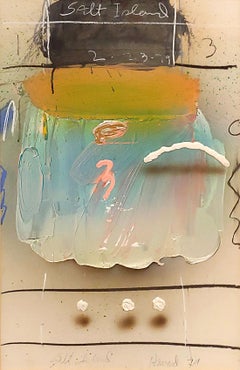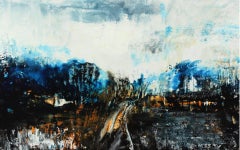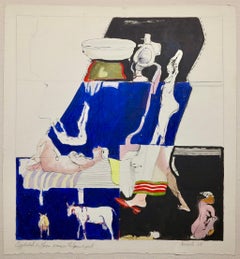James Havard Art
American, b. 1937
For more than 40 years, James Havard has been producing paintings, prints, collages, and sculptures that defy categorization, ranging from abstraction and illusionism to figuration, combining and pioneering styles, and drawing from indigenous and tribal cultures and art history to create an exuberant visual language at once hermetic and universal. He first gained recognition in the 1970s for pioneering an approach to painting, known as “Abstract Illusionism,” in which individual brushstrokes and abstract forms were shaded to appear three-dimensional. By the late 1980s, he turned to figuration, populating his compositions with radically pared-down, roughly hewn male and female figures inspired by Native American, African tribal, and pre-Colombian art, cave painting, and children’s drawings, and recalling Art Brut. Raw, expressive, and, ultimately, enigmatic, these figures also appear in Havard’s boxed collages and sculptures—a medium he began exploring in 2002.to
1
Overall Width
to
Overall Height
to
1
1
1
1
1
1
1
1
1
10,042
2,762
1,381
1,375
1
1
Artist: James Havard
Museum Collected artist Abstract Illusion acrylic painting on board 37x27"
By James Havard
Located in Southampton, NY
James Havard is considered one of the "pioneers of the abstract illusionism movement" One of James Havard's homes and studio's was on the island of Tortola and this work from 1979 evokes the feel of the aqua blue waters and the reference of Salt Island in the painting refers to the island of Tortola and the feel of the ocean waters.
In the 1970's Havard was the principle artist that started working in an abstract style that included gestural brush strokes and paint squeezed directly from the tube to create beautiful surface textures in his paintings. He then painted shadows to certain areas of paint to create the 3d illusion of depth to his paintings. This created the "Abstract Illusion" movement of the 1970's. Havard had many museum exhibitions and his paintings were sort after and exhibited at galleries around the world. Havard along with other artists like, Michael Gallagher, George Green...
Category
1970s Abstract James Havard Art
Materials
Acrylic, Board
Related Items
Feminine Red And Black Modern Abstract Structured Painting By Sture Wikström
Located in Frederiksberg C, DK
Presenting a modern abstract composition with a textured impasto surface created by the Swedish artist, Sture Wikström (1921-1993). With its textured su...
Category
Late 20th Century Abstract James Havard Art
Materials
Acrylic, Board
$295
H 25.99 in W 30.71 in
Landscape - XXI century, Contemporary Oil & Acrylic Painting, Abstraction
By Monika Rossa
Located in Warsaw, PL
MONIKA ROSSA
studied painting at the University of Arizona, in the Ecole des Beaux Arts in Paris and at the Escuela de Diseno in Barcelona. She practices drawing and easel painting....
Category
21st Century and Contemporary Abstract James Havard Art
Materials
Oil, Acrylic, Board
$896
H 14.97 in W 24.02 in
Crows. Contemporary Mixed Media Painting, Abstraction, Birds, Polish art
By Anna Mikke
Located in Warsaw, PL
Contemporary mixed media on board painting by Polish artist Anna Mikke. Birds are next to people favourite artistic subject of Mikke. This piece is in neutral colors, the background ...
Category
Early 2000s Abstract James Havard Art
Materials
Pastel, Acrylic, Gouache, Board
$657
H 31.11 in W 17.72 in
Colorful Portrait Painting on Board by Peter Keil
By Peter Keil
Located in Hudson, NY
This modern abstract painting by Peter Keil is on a smooth masonite board with a painted grey background, black abstract portrait with many colors. Here you certainly see the Picasso...
Category
Late 20th Century Abstract James Havard Art
Materials
Masonite, Acrylic, Board
$464 Sale Price
45% Off
H 24 in W 16 in D 0.25 in
Curved Lines 22
Located in King, ON
This abstract painting is from new series “Curved Lines” and inspired by nature. Performed in Minimalism, Modern Art and Hard Edge styles.
This work is signed, dated and tilted by Ar...
Category
2010s Abstract James Havard Art
Materials
Canvas, Acrylic, Cardboard
"Red Moon" - contemporary abstract acrylic painting on board
Located in Nyack, NY
Abstract acrylic painting on wood panel by artist Martha Lloyd.
About the artist:
Martha Anne Lloyd was born in Washington, D.C. in 1927. An avid artist...
Category
Early 2000s Abstract James Havard Art
Materials
Acrylic, Board
$300
H 16 in W 18 in D 0.5 in
Landscape - XXI century, Contemporary Oil & Acrylic Painting, Abstraction
By Monika Rossa
Located in Warsaw, PL
MONIKA ROSSA
studied painting at the University of Arizona, in the Ecole des Beaux Arts in Paris and at the Escuela de Diseno in Barcelona. She practices drawing and easel painting....
Category
21st Century and Contemporary Abstract James Havard Art
Materials
Oil, Acrylic, Board
$896
H 14.97 in W 25.2 in
"Monastery Garden" - acrylic & fabric collage on board, floral art
Located in Nyack, NY
Contemporary acrylic paint and fabric collage artwork on board by artist Martha Lloyd.
Vibrant red, blue and teal with black, featuring motifs of squares...
Category
Early 2000s Abstract James Havard Art
Materials
Acrylic, Fabric, Board
$250
H 16 in W 18 in D 0.75 in
Signals of Stillness — Abstract Painting on Cardboard by Emmi Iida
Located in Lahti, FI
“Signals of Stillness” is an original 54 x 47 cm acrylic painting on cardboard by Finnish multidisciplinary artist Emmi Iida, celebrated for her intuitive mark-making and emotional m...
Category
2010s Abstract Expressionist James Havard Art
Materials
Oil Pastel, Acrylic, Cardboard, Pencil
$944
H 21.26 in W 18.51 in
Echo In Motion, Abstract Mixed-Media Painting on Paper by Emmi Iida
Located in Lahti, FI
“Echo in Motion” is an original abstract work on paper by Finnish multidisciplinary artist Emmi Iida, known for her emotionally charged and intuitive compositions that merge gesture, texture, and flow.
This 2023 piece captures a moment of raw movement and organic tension — strokes of gray, black, and ochre interlace with fluid drips and translucent washes. The composition feels spontaneous yet deeply intentional, like a visual echo of a fleeting emotion or thought suspended in air. The exposed paper acts as negative space, giving the piece a quiet balance between chaos and stillness.
Executed with acrylics and mixed media on fine art paper, “Echo in Motion” reflects Emmi Iida’s continued exploration of energy and emotion through abstraction — a meditation in motion, ideal for collectors drawn to expressive yet minimalist works on paper.
About the Artist:
Emmi Iida is an internationally exhibiting artist, author, musician and interior architect, working at the intersection of visual art, sound, and design. Her practice is rooted in Nordic minimalism and emotional depth, infused with a global perspective from her years living and creating across Europe and the United States.
Her works have been acquired by collectors from New York to Los Angeles, Sydney to Paris, and she is currently represented by MONAT Gallery (Paris, Madrid, Innsbruck) and Van Gogh Art Gallery (Munich, Miami). Upcoming exhibitions include international art fairs and group shows in Europe and the United States in 2025.
Abstract Art...
Category
2010s Abstract Expressionist James Havard Art
Materials
Oil Pastel, Acrylic, Cardboard, Pencil
$944
H 21.26 in W 18.51 in
Landscape - XXI century, Contemporary Oil & Acrylic Painting, Abstraction
By Monika Rossa
Located in Warsaw, PL
MONIKA ROSSA
studied painting at the University of Arizona, in the Ecole des Beaux Arts in Paris and at the Escuela de Diseno in Barcelona. She practices drawing and easel painting....
Category
21st Century and Contemporary Abstract James Havard Art
Materials
Oil, Acrylic, Board
$896
H 14.97 in W 25.2 in
Landscape - XXI century, Contemporary Oil & Acrylic Painting, Abstraction
By Monika Rossa
Located in Warsaw, PL
MONIKA ROSSA
studied painting at the University of Arizona, in the Ecole des Beaux Arts in Paris and at the Escuela de Diseno in Barcelona. She practices drawing and easel painting....
Category
21st Century and Contemporary Abstract James Havard Art
Materials
Oil, Acrylic, Board
$896
H 13.78 in W 21.26 in
Previously Available Items
Exploded Bathroom Views with Spanish Goat (mid-century surrealist painting)
By James Havard
Located in Wilton Manors, FL
James Havard (b.1937). Exploded Bathroom Views with Spanish Goat, 1965. Pencil, watercolor and gouache on paper glued down to matte board. Sheet measures 20.5 x 19 inches; 24 x 26 inches on matting. Excellent condition. Signed, title and dated lower margin. Unframed. Although known as a Sant a Fe, NM artist, Havard attended PAFA in Philadelphia 1961-65. This piece is an outstanding example from the artist's 1960's experimental period. Provenance: Philadelphia estate.
Havard was born in Galveston, Texas, in 1937. Although he entered Houston State College on an agricultural scholarship, shortly thereafter, he turned his interests to the visual arts. Intrigued by the East, he moved upon graduation in 1959 to Philadelphia where he attended the Pennsylvania Academy of the Fine Arts. Havards early work focused on still lifes and more traditional forms of art making, but by the early 1960s experimentation and rule-breaking was replacing the accepted norms of the school.
Avoiding pop art, Havard instead delved into minimalism and began a twenty-year professional relationship with noted Marion Locks Gallery in Philadelphia with his first solo show there in 1970. During this time he began to experiment with industrial materials, vacuformed plastic shapes and metallic paints from the auto body show beneath his studio. Finding the luminescence of his new pearlescent surfaces more lyrical in quality, Havard scratched and abraded the surface of these works and soon realized the illusionistic techniques that could be controlled by the use of airbrushing. These original experimentations were later refined into the painterly, abstract trompe loeil gestures for which he is known today.
Rich squeezings of paint squirted directly onto the canvas surface contrasted against subtle pastel backgrounds became his trademark by the late 1970s. "Abstract illusionism," actually more of a commercial term used to define his work, overshadowed his interest in the Native American subject matter which would become as important, in time, as his bravura painting style. Making reference in text or figurative reference to the Arapaho, Iroquois, and episodes in Native American history, Havard infused his expressive work with poetic metaphors about Native American artifacts and culture (while several exhibitions of Native American art have included works by James Havard, he denies any specific, official affiliation with any particular tribe).
After moving to New York City in the 1980s, Havard focused on large-scale, expressive paintings referencing Native American culture in a most unique way. Over the next ten years, he made frequent visits to Santa Fe, New Mexico, for inspiration and to pursue his interest in collecting. Havards style of blending expressionistic abstraction with indigenous symbols caught the attention of museums through the country and soon his works were added to several important collections, including the Metropolitan Museum of Art, the Los Angeles County Museum of Art and the Solomon R. Guggenheim Museum of Art. Havard was now exhibiting his work in Sweden, Australia, New York and Paris and newspapers from the Houston Post to the New York Times were reviewing his exhibitions. His works became even more colorful and expressive and iconistic than ever before.
In 1989 Havard moved to Santa Fe, New Mexico. In contrast to previous decade, his work became smaller, partly due to the limitations of his new studio space, but his repertoire of images expanded to include early American images and icons and even personal whimsy such as abstracted references to his love of the sport of golf. Once again employing the use of industrial technology, Havard added photo silk screened images of Hopi masks and tabletas and motifs from Zuni pottery...
Category
Mid-20th Century Surrealist James Havard Art
Materials
Mixed Media
H 20.5 in W 19 in D 0.08 in
James Havard art for sale on 1stDibs.
Find a wide variety of authentic James Havard art available for sale on 1stDibs. If you’re browsing the collection of art to introduce a pop of color in a neutral corner of your living room or bedroom, you can find work that includes elements of purple and other colors. You can also browse by medium to find art by James Havard in paint, mixed media, acrylic paint and more. Much of the original work by this artist or collective was created during the 21st century and contemporary and is mostly associated with the contemporary style. Not every interior allows for large James Havard art, so small editions measuring 4 inches across are available. Customers who are interested in this artist might also find the work of David Mellen, Gary Komarin, and Bill Maggio. James Havard art prices can differ depending upon medium, time period and other attributes. On 1stDibs, the price for these items starts at $6,000 and tops out at $25,000, while the average work can sell for $12,000.


